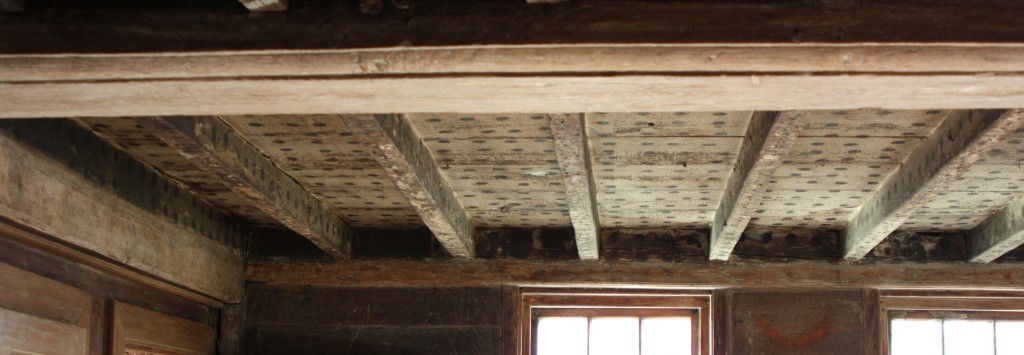Sometimes a Kitchen Just Wants to Look Pretty
With Patriots’ Day putting the Arlington Historical Society’s Jason Russell House back in the news, I followed a path to this 2015 article from the Arlington Advocate about something else notable in that house: the dotted pattern the kitchen ceiling.
Surviving free-hand painting in Colonial interiors is rare, but it is preserved on the ceilings (and sometimes the wall sheathing) of a few other 17th and 18th century New England houses. For example, the kitchen ceiling of the Buckman Tavern in Lexington is enlivened with roughly painted chevrons; the White-Ellery House in Gloucester displays a pattern of semi-circular slashes; and a portion of a preserved ceiling from a demolished house in Dartmouth goes wild with a combination of commas, chevrons and a few splashes of color.The Jason Russell House is open for visitors every Saturday and Sunday from 1:00 to 4:00 P.M. until Columbus Day.
The decorative technique employed in the Russell kitchen is one that Colonials called “spotting,” now sometimes referred to as “sponge painting.” Only a handful of similar examples still exist. The wall sheathing of the upper hallway of the Boardman House in Saugus reveals a fairly regular pattern of black dots of about one and a quarter inches in diameter on a light background, while the kitchen ceiling of the Sherburne House in Strawbery Banke Museum in Portsmouth, New Hampshire, is boldly decorated with larger grey dots on a dark red ceiling.
Closer to home, the inside of a small, bullet-scarred door panel from the old Adams House, now in the Arlington Historical Society collection, shows an irregular distribution of starburst-like black spots on an unpainted wood ground. In none of these instances does it seem that the painters employed an actual sponge; instead, they may have applied their spots by skillfully twirling a round brush or by stamping the pattern on with a blunt, semi-absorbent object such as the broad end of a corncob.
Spotting and other decorative ceiling designs reached their popular peak around the turn of the 18th century, and the Russells’ spotted ceiling therefore would seem to support an earlier theory that the house was built the 1680s. However, later scholarship and a dendrochronology study in 2012 suggest a construction date of 1740-1750. Such a late date for the Russell polka dots is not out of the question. In 1738, for example, the painter Samuel Heath charged the Province of Boston for “colouring and spotting a Large Kitchen” in the no longer extant Province House.
The Jason Russell House’s polka-dotted ceiling probably owes its survival to the fortunate decision by a later Russell resident of the house to ‘modernize’ by plastering it over. Thus, it was safely preserved until the Historical Society’s restoration in 1924.


No comments:
Post a Comment